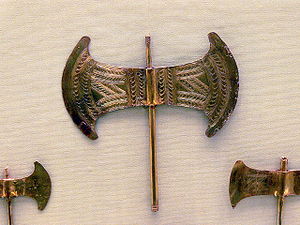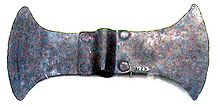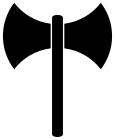Labrys
This article has multiple issues. Please help improve it or discuss these issues on the talk page. (Learn how and when to remove these template messages)
|

Labrys (Greek: λάβρυς, lábrys) is, according to Plutarch (Quaestiones Graecae 2.302a) the Lydian word for the double-bitted axe called in Greek a πέλεκυς (pelekus). This is all that is known with certainty about the word; everything else is conjecture.[1] On this dubious base, many elaborate theories have been posited linking it to the double axe of the Minoans and other societies.
Etymology
Plutarch relates that the word labrys was a Lydian word for "axe": Λυδοὶ γὰρ ‘λάβρυν’ τὸν πέλεκυν ὀνομάζουσι.[2]
Despite theories to the contrary, there is no evidence that the word was ever used in the Aegean. No corresponding form is attested in Minoan Linear A.[3] Moreover, it is far from clear that the word labyrinth is either connected to it or attested in Linear B. The inscription 𐀅𐁆𐀪𐀵𐀍𐀡𐀴𐀛𐀊, on tablet ΚΝ Gg 702, reads da-pu2-ri-to-jo-po-ti-ni-ja. The conventional reading of λαβυρίνθοιο πότνια ("mistress of the labyrinth") is not obvious nor perhaps defensible. That the first sign is da rather than ra (which can also be read "la") is strange, though not perhaps inexplicable.[4] The bigger problem is reading pu2 as "bu." In every case where a word spelled using that sign can be identified with a known Greek word, the reading is invariably "fu" (i.e. φυ, an aspirated unvoiced labial). The only place where it might be thought to represent "bu" is in this very word, based entirely on the thought that it should be read as a form of labyrinth.[5] In a vacuum, this word would be read *δαφυρίνθοιο, or something similar. There is, therefore, no certain link with either the λάβρυς or the labyrinth.
A link has also been posited with the double axe symbols at Çatal Höyük, dating to the neolithic age.[6] In Labraunda of Caria the double-axe accompanies the storm-god Zeus Labraundos.[7]
The Minoan Double Axe

As mentioned, the labrys is often associated with the Minoans. There is no doubt that, on Crete, the double axe was an important cultic symbol.[8] However, there is no evidence to link the word labrys with this Minoan symbol.
Double Axes in the Near East
In the Near East and other parts of the region, eventually, axes of this sort are often wielded by male divinities and appear to become symbols of the thunderbolt,[9] a symbol often found associated with the axe symbol. In Labraunda of Caria the double-axe accompanies the storm-god Zeus Labraundos. Similar symbols have been found on plates of Linear pottery culture in Romania.[10] The double-axe is associated with the Hurrian god of sky and storm Teshub. His Hittite and Luwian name was Tarhun.[11] Both are depicted holding a triple thunderbolt in one hand, and a double axe in the other hand.[12] Similarly, Zeus throws his Keravnos to bring storm. The labrys, or pelekys, is the double axe Zeus uses to invoke storm, and the relative modern Greek word for lightning is star-axe (ἀστροπελέκι astropeleki)[13] The worship of it was kept up in the Greek island of Tenedos and in several cities in the south-west of former Hellenic Asia Minor, and it appears in later historical times in the cult of the thunder god of Asia Minor (Zeus Labrayndeus).
Ancient Greece
In the context of the Classical Greek myth of Theseus, the labyrinth of Greek mythology is frequently associated with the Minoan palace of Knossos. This is based on the unlikely reading of Linear B da-pu2-ri-to-jo-po-ti-ni-ja as λαβυρίνθοιο πότνια ("mistress of the labyrinth").[14] Even if that is the correct reading, there is no evidence to suggest that this referred to Knossos itself, as is often asserted. It could equally be a smaller sanctuary, or else an entirely separate location.[15] Ignoring all the difficulties in assuming that labyrinth can be interpreted as "place of the double axes" there is moreover no reason to think this should be Knossos; many more have been found, for example, at the Arkalachori Cave, where the famous Arkalochori Axe was found. Ultimately, only a fragile chain of conjecture can link Theseus to the word labrys.
On Greek coins of the classical period (e.g. Pixodauros, etc.) a type of Zeus venerated at Labraunda in Caria that numismatists call Zeus Labrandeus (Ζεὺς Λαβρανδεύς) stands with a tall lotus-tipped sceptre upright in his left hand and the double-headed axe over his right shoulder.
Modern uses

In feminist interpretations, the labrys is a symbol of matriarchy.[16]
While double axes are common in modern high fantasy settings, in reality, they were not commonly used in combat.
The labrys was formerly a symbol of Greek fascism.[17] During the period of the 4th of August Regime (1936–1941), the labrys was used as the main symbol of the regime-sponsored National Organisation of Youth (EON),[17] as its leader, Ioannis Metaxas believed the symbol to be the first symbol of all Hellenic civilisations. In the 1960s the labrys was also used by the Italian neo-fascist and far-right movement Ordine Nuovo, most prominently on their flag. Today it is sometimes used as a symbol of Hellenic Polytheistic Reconstructionism.
Further, it is used by Cretan folklore preservation societies and associations both in Greece and abroad, on occasion with the modern Greek spelling "lavrys".
The labrys, as a historic goddess movement symbol represents the memory of pre-patriarchal matristic societies.[18] Since the 1970s,[19][20] It also has been used as a lesbian[20] and feminist,[21] symbol, said to represent women's strength and self-sufficiency.[22]
There is also an organization for LGBT rights in Kyrgyzstan called the Labrys Organization. The group's goal is to improve the quality of life for all LGBT individuals in their country as well as the surrounding Central Asian region.[23]
See also
| Part of the LGBT series |
| LGBT symbols |
|---|
| Symbols |
| Pride flags |
- Arkalochori Axe
- Axe (tool)
- Battle-axe
- Bronze Age sword
- Fasces
- Francisca
- Sagaris
- Labrys religious community
Notes
- ^ Beekes, Robert (2010). Etymological Dictionary of Greek. Boston: Leiden Brill. p. 819.
- ^ "Herakles, having slain Hippolyte and taken her axe away from her with the rest of her arms, gave it to Omphale. The kings of Lydia who succeeded her carried this as one of their sacred insignia of office, and passed it down from father to son until it was passed to Candaules, who disdained it and gave it to one of his companions to carry. When Gyges rebelled and was making war upon Candaules, Arselis came with a force from Mylasa to assist Gyges; Arselis then slew Candaules and his companion and took the axe to Caria with the other spoils of war. And, having set up a statue of Zeus, Arselis put the axe in his hand and invoked the god, Labrandeus". Plutarch, Greek Questions, 45 2.302a.
- ^ Younger, John (2017-11-29). "Linear A Lexicon"There is no form *LA-PU-RU or *DA-PU-RU.
{{cite web}}: Cite has empty unknown parameter:|dead-url=(help)CS1 maint: postscript (link) - ^ cf. the Pre-Greek word δάφνη (laurel), which has an alternate form λάφνη.
- ^ See Melena's overview in the third volume of the Companion to Linear B, p. 73 (available here)
- ^ F.Schachermeyer (1964) Die Minoische Kultur des alten Kreta. W.Kohlhammer Stuttgart p. 161, Abb.85
- ^ "It seems natural to interpret names of Carian sanctuaries like Labranda in the most literal sense as the place of the sacred labrys, which was the Lydian (or Carian) name for the Greek πέλεκυς [pelekys], or double-edged axe." And, p. 109, "On Carian coins, indeed of quite late date, the labrys, set up on its long pillar-like handle, with two dependent fillets, has much the appearance of a cult image.":A.J. Evans, "Mycenaean tree and pillar cult and its Mediterranean relations," Journal of Hellenic Studies XXI, pp 108, 109.
- ^ Rutter, Jeremy (2017-11-29). "Minoan Religion".
{{cite web}}: Cite has empty unknown parameter:|dead-url=(help) - ^ Dartmouth College: Minoan Religion
- ^ F. Schachermeyer:Die Minoische Kultur des alten Kreta. p. 162, W.Kohlhammer Verlag Stuttgart
- ^ Tarhun
- ^ Teshub
- ^ M. Nilsson (1967), Die Geschichte der Griechische Religion, Vol. I, C. F. Beck Verlag, Munich, pp. 276–277
- ^ For the problems with this, see the "Etymology" section above.
- ^ cf. the parallel construction of a-ta-na-po-ti-ni-ja, perhaps referring to the “Mistress of Athens”, i.e. Athena, on a different tablet (KN V 52) from Knossos).
- ^ The forms taken by the labrys were classified by Caterina Mavriyannaki, "La double hache dans le monde héllenique à l'âge du bronze," Revue Archéologique, New series (1983:195-228).
- ^ a b Markessinis, Andreas (August 22, 2006). "The Labrys/Pelekys: The symbol of Thundergod Zeus and of the EON". Metaxas Project. Retrieved August 31, 2014.
- ^ Keller, Mara (1988). "Eleusinian Mysteries" (PDF). Journal of Feminist Studies in Religion (Vol 4 No 1): 42. Retrieved 2016-06-21.
{{cite journal}}:|issue=has extra text (help) - ^ Cottingham, Laura (1996). Lesbians Are So Chic. Bloomsbury. ISBN 9780304337217. Retrieved 26 June 2014.
- ^ a b Murphy, Timothy (2013-10-18). Reader's Guide to Lesbian and Gay Studies. Routledge. p. 44ff. ISBN 9781135942342. Retrieved 26 June 2014.
- ^ Morrow, Deana F.; Messinger, Lori (2006-04-02). Sexual Orientation and Gender Expression in Social Work Practice: Working with Gay, Lesbian, Bisexual, and Transgender People. Columbia University Press. pp. 476–. ISBN 9780231127295. Retrieved 26 June 2014.
- ^ SwadePages "Origin & History of Gay & Lesbian Symbols"
- ^ http://weltkind.com), programming by weltkind (anatoly lelevkin -. "Labrys Kyrgyzstan :: Freedom to be!". www.labrys.kg. Retrieved 2016-05-11.
External links
- Pagan Protection Center list of symbols, includes an article on Labrys.
- Metaxas Project: Inside Fascist Greece
- Labrys Hellenic polytheistic religious community (Greek & English)

